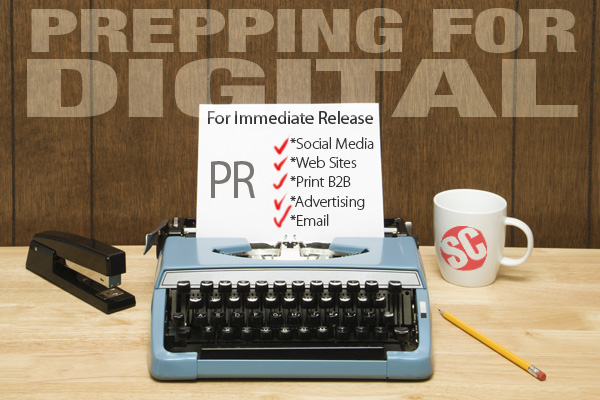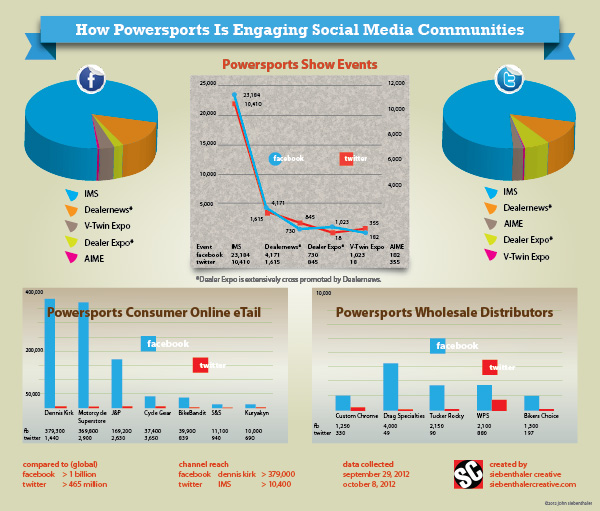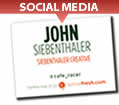
Prepping A Press Release For Social Performance
July, 2014 | by John Siebenthaler
From Print to Pixel The days of gorgeously prepared and expensively printed pocket folder press kits now have a special section over in the Hall of Extinction.
 Releases that once took days to create and weeks to distribute are now expected to be up and running before the morning paper hits the driveway. Or before the smartphone is checked for updates over the first cup of coffee.
Releases that once took days to create and weeks to distribute are now expected to be up and running before the morning paper hits the driveway. Or before the smartphone is checked for updates over the first cup of coffee.
Creating publicity that works in the online space means using a workflow that includes a holistic approach to content creation. Even though a press release seems like a simple writing exercise, the actual construction requires a blend of professional, technical, and creative skills acting in unison.
The emerging concept goes far beyond the plain text email with one or more hitchhiking file attachments and an appearance that is best described as sure do miss my AOL dialup.
Performance based publicity talks to several publics simultaneously, blending multi-channel content into a small footprint package of easily sourced information that should include email signup, social channel connections, and resource references.
Here are a few ideas on how to garner earned publicity in an online social era.
Copy
An editor’s job isn’t to rewrite and correct your material. An optimized release still starts with a traditional foundation of well crafted copy that offers plenty of options. Period.
Self-generated releases continue to surface with a weirdly stiff formality and awkward construction that drones on with content no one wants to read – not even your mom.
Even though a press release seems like a simple writing exercise, the actual construction requires a blend of professional, technical, and creative skills acting in unison.
Using a normal conversational style is still the best way to attract readers and usually conveys more credibility and just plain friendliness than a weighty monument to excess.
Important keys for success in the cut-and-paste race to publish content include brevity, accuracy, coherance, and context. Using social media’s unique voice as part of a well crafted release gets bonus points for ease of integration.
When editing use that red marker liberally and often: run fast and far from any intro that includes, “…is thrilled to announce.” No. Body. Cares.
AP style is the bible journalists use for writing customs and expressions. It’s five barking dogs, not 5, and that alone could well mean the difference between acceptance or rejection.
The typical product release might see 30 words published online or in print. A good approach is to provide four times that, broken up into bite size paragraphs that are easy for an editor to quickly scan and schedule. Description. Benefit. Pricing. Availability. Short bursts of targeted info work best.
Humor? Only if others think you’re funny, and you have the standup gigs to prove it.
Lead - or lede - with a strong headline. Think strategically. Write to 70 characters or fewer that can double as a web page title that Google won’t truncate. Follow that up with a sentence or two that will function as a meta description, meaning 160 characters or less.
Art & Illustration
Sending out a release that offers professional imagry can really improve positive exposure, according to a study by the National Press Photographers Association. Including art meant for reproduction also adds a professional touch. A well crafted visual or visuals can carry a so-so release to prominence, whereas text only may compromise successful placement.
 Infographics and presentations can quickly convey detailed information. There are plenty of applications and cloud-based platforms for generating content – Powerpoint not included – that offer impressive capabilities to tap into.
Infographics and presentations can quickly convey detailed information. There are plenty of applications and cloud-based platforms for generating content – Powerpoint not included – that offer impressive capabilities to tap into.
Page load speeds should be considered when including art, especially for mobile devices. Raster graphics might include both lo and high-res (if needed) versions, optimized for print or onscreen.
The difference between screen resolution of 72-dpi and the typical print requirement of a discretionary 300-dpi can be seen when two identical images use the same dimensions, but different resolutions. The difference is in file size. Retina displays (best expressed as screen pixel dimensions) notwithstanding, there's no need for a hi-res image that’s a resource hog when screen res works just fine.
Use an ftp site or direct link to move the files. Trying to cram a 50-meg collection of JPGs through an editors e-mail pipeline will result in someone getting stricken from the trusted email address book.
Ftp transfers are smooth, quick, efficient, don’t clog up the editor’s in-box, and provide a convenient route for editors and art directors to follow. You can also link to dot-zipped art stored on a web page for convenience.
Web Considerations

Focusing on quality in the creation of content and the preparation of materials leads to a successful campaign.
Provide an easy to follow online resource path for your audience. Make sure that new widget has a prominent position in your site’s online newsroom.
More info — supporting tech tables, PDFs crammed with browseable art, offers, newsletter signups, etc. — is always welcomed by editors curious enough to light up your URL as you search for engagement and they screen for filler, topical content, and relevancy.
Properly prepared material is critically important. Publicity created with an appreciation for how the search gatekeepers reward or punish efforts to inform and persuade is essential if any liftoff is to be obtained.
As Google continues to refine how their robots see, interpret, and report content, quality is increasingly understood to be one of the key indicators of who sees what and under what circumstances.
When it comes to links in your release, do whatever it takes to avoid looking like spam. Forget keyword stuffing (you’re not still doing that are you?) and make sure any links can be read by robots as contextual to the content. Keep the link count low for the same reason.
Do you qualify as a publisher that can be included in Google News? If so, the rich snippets keyword meta tag could be very helpful. There are a lot of variables, but generally when properly set up and implemented this will help you get noticed in the Google News search returns, different from the general pages Google returns on search.
A clearly labeled blog entry can be more effective than a static web page when it comes to reach, and an effective strategy could include both in a well balanced publishing platform.
Ready to go social content will set your work apart from competitors. Providing a couple of well-crafted 140-character sample posts boosts the chances a release will make it into a feed. At the very least it will show a harried social manager you care.
Finally, use whichever social channels are most appropriate to push distribution. The Big Three include Twitter, Facebook, and Google+, closely followed by Instagram, Pinterest, YouTube, and many others serving distinct online groups.





